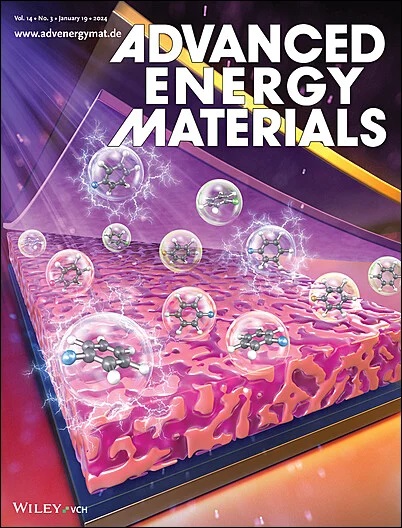Molecular Bridging at Buried Interface Enables Efficient Wide‐Bandgap Perovskite Solar Cells
IF 24.4
1区 材料科学
Q1 CHEMISTRY, PHYSICAL
引用次数: 0
Abstract
The regulation of buried interface is crucial for high‐performance wide‐bandgap perovskite solar cells (PSCs), which can influence the interfacial defects, the charge transport, and the crystallization of perovskites. In this work, a facile strategy is reported of inserting a multi‐functional (Z)‐4‐Fluoro‐埋藏界面上的分子桥接可实现高效的宽禁带钙钛矿太阳能电池
埋藏界面的调节对高性能宽禁带钙钛矿太阳能电池(PSCs)至关重要,它可以影响钙钛矿的界面缺陷、电荷输运和结晶。在这项工作中,报告了一种简单的策略,即在自组装单层(SAM)和宽带隙(WBG)钙钛矿层之间插入多功能(Z)‐4‐氟‐N′‐羟基苯并咪胺(4F‐HBM)分子,积极调节晶体生长并促进空穴提取。发现4F‐HBM中的F原子与SAM形成氢键。4F‐HBM与钙钛矿中的Pb2+相互作用,有效降低了界面处的缺陷态密度和埋藏界面处的非辐射电荷复合损失。采用4F‐HBM的1.77 eV WBG PSC的功率转换效率显著提高至20.09%,填充系数高达84.71%,高于控制器件的18.47%和82.53%。在最大功率点跟踪821 h后,器件仍能保持原有效率的85%,稳定性得到提高。四端全钙钛矿串联太阳能电池通过将这种半透明WBG亚电池与1.25 eV低带隙PSC相结合,获得了28.71%的PCE,是迄今为止四端全钙钛矿串联电池的最高效率之一。这项工作为增强钙钛矿基串联器件的埋藏界面接触和缺陷钝化提供了一种有前途的策略。
本文章由计算机程序翻译,如有差异,请以英文原文为准。
求助全文
约1分钟内获得全文
求助全文
来源期刊

Advanced Energy Materials
CHEMISTRY, PHYSICAL-ENERGY & FUELS
CiteScore
41.90
自引率
4.00%
发文量
889
审稿时长
1.4 months
期刊介绍:
Established in 2011, Advanced Energy Materials is an international, interdisciplinary, English-language journal that focuses on materials used in energy harvesting, conversion, and storage. It is regarded as a top-quality journal alongside Advanced Materials, Advanced Functional Materials, and Small.
With a 2022 Impact Factor of 27.8, Advanced Energy Materials is considered a prime source for the best energy-related research. The journal covers a wide range of topics in energy-related research, including organic and inorganic photovoltaics, batteries and supercapacitors, fuel cells, hydrogen generation and storage, thermoelectrics, water splitting and photocatalysis, solar fuels and thermosolar power, magnetocalorics, and piezoelectronics.
The readership of Advanced Energy Materials includes materials scientists, chemists, physicists, and engineers in both academia and industry. The journal is indexed in various databases and collections, such as Advanced Technologies & Aerospace Database, FIZ Karlsruhe, INSPEC (IET), Science Citation Index Expanded, Technology Collection, and Web of Science, among others.
 求助内容:
求助内容: 应助结果提醒方式:
应助结果提醒方式:


